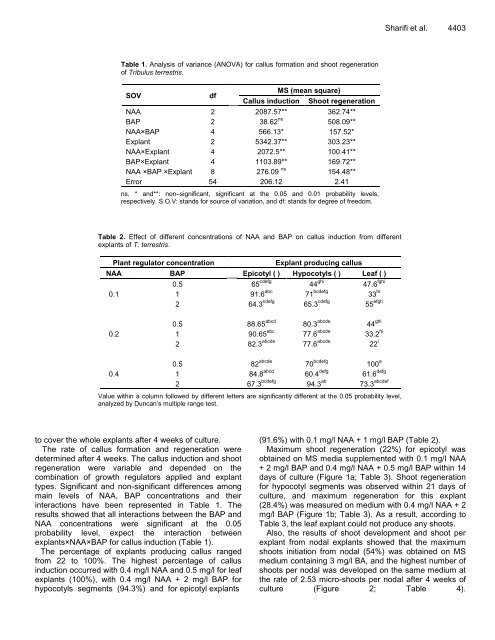Download Complete Issue (4740kb) - Academic Journals
Download Complete Issue (4740kb) - Academic Journals
Download Complete Issue (4740kb) - Academic Journals
You also want an ePaper? Increase the reach of your titles
YUMPU automatically turns print PDFs into web optimized ePapers that Google loves.
Table 1. Analysis of variance (ANOVA) for callus formation and shoot regeneration<br />
of Tribulus terrestris.<br />
SOV df<br />
MS (mean square)<br />
Callus induction Shoot regeneration<br />
NAA 2 2087.57** 362.74**<br />
BAP 2 38.62 ns 508.09**<br />
NAA×BAP 4 566.13* 157.52*<br />
Explant 2 5342.37** 303.23**<br />
NAA×Explant 4 2072.5** 100.41**<br />
BAP×Explant 4 1103.89** 169.72**<br />
NAA ×BAP ×Explant 8 276.09 ns 154.48**<br />
Error 54 206.12 2.41<br />
ns, * and**: non–significant, significant at the 0.05 and 0.01 probability levels,<br />
respectively. S.O.V: stands for source of variation, and df: stands for degree of freedom.<br />
Table 2. Effect of different concentrations of NAA and BAP on callus induction from different<br />
explants of T. terrestris.<br />
Plant regulator concentration Explant producing callus<br />
NAA BAP Epicotyl ( ) Hypocotyls ( ) Leaf ( )<br />
0.5 65<br />
0.1<br />
cdefg 44 ghi 47.6 fghi<br />
1 91.6 abc 71 bcdefg 33 hi<br />
2 64.3 cdefg 65.3 cdefg 55 efgh<br />
0.2<br />
0.4<br />
0.5 88.65 abcd 80.3 abcde 44 ghi<br />
1 90.65 abc 77.6 abcde 33.2 hi<br />
2 82.3 abcde 77.6 abcde 22 i<br />
0.5 82 abcde 70 bcdefg 100 a<br />
1 84.8 abcd 60.4 defg 61.6 defg<br />
2 67.3 bcdefg 94.3 ab 73.3 abcdef<br />
Value within a column followed by different letters are significantly different at the 0.05 probability level,<br />
analyzed by Duncan’s multiple range test.<br />
to cover the whole explants after 4 weeks of culture.<br />
The rate of callus formation and regeneration were<br />
determined after 4 weeks. The callus induction and shoot<br />
regeneration were variable and depended on the<br />
combination of growth regulators applied and explant<br />
types. Significant and non-significant differences among<br />
main levels of NAA, BAP concentrations and their<br />
interactions have been represented in Table 1. The<br />
results showed that all interactions between the BAP and<br />
NAA concentrations were significant at the 0.05<br />
probability level, expect the interaction between<br />
explants×NAA×BAP for callus induction (Table 1).<br />
The percentage of explants producing callus ranged<br />
from 22 to 100%. The highest percentage of callus<br />
induction occurred with 0.4 mg/l NAA and 0.5 mg/l for leaf<br />
explants (100%), with 0.4 mg/l NAA + 2 mg/l BAP for<br />
hypocotyls segments (94.3%) and for epicotyl explants<br />
Sharifi et al. 4403<br />
(91.6%) with 0.1 mg/l NAA + 1 mg/l BAP (Table 2).<br />
Maximum shoot regeneration (22%) for epicotyl was<br />
obtained on MS media supplemented with 0.1 mg/l NAA<br />
+ 2 mg/l BAP and 0.4 mg/l NAA + 0.5 mg/l BAP within 14<br />
days of culture (Figure 1a; Table 3). Shoot regeneration<br />
for hypocotyl segments was observed within 21 days of<br />
culture, and maximum regeneration for this explant<br />
(28.4%) was measured on medium with 0.4 mg/l NAA + 2<br />
mg/l BAP (Figure 1b; Table 3). As a result, according to<br />
Table 3, the leaf explant could not produce any shoots.<br />
Also, the results of shoot development and shoot per<br />
explant from nodal explants showed that the maximum<br />
shoots initiation from nodal (54%) was obtained on MS<br />
medium containing 3 mg/l BA, and the highest number of<br />
shoots per nodal was developed on the same medium at<br />
the rate of 2.53 micro-shoots per nodal after 4 weeks of<br />
culture (Figure 2; Table 4).

















